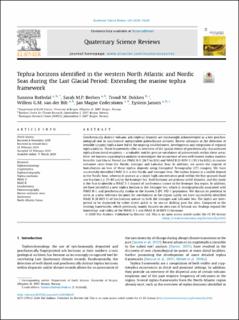Tephra horizons identified in the western North Atlantic and Nordic Seas during the Last Glacial Period: Extending the marine tephra framework
Rutledal, Sunniva; Berben, Sarah Miche Patricia; Dokken, Trond Martin; Bilt, Willem van der; Cederstrøm, Jan Magne; Jansen, Eystein
Journal article, Peer reviewed
Published version

Åpne
Permanent lenke
https://hdl.handle.net/11250/2736462Utgivelsesdato
2020Metadata
Vis full innførselSamlinger
- Department of Earth Science [1050]
- Registrations from Cristin [9791]
Sammendrag
Geochemically distinct volcanic ash (tephra) deposits are increasingly acknowledged as a key geochronological tool to synchronize independent paleoclimate archives. Recent advances in the detection of invisible (crypto) tephra have led to the ongoing establishment, development and integration of regional tephra lattices. These frameworks offer an overview of the spatial extent of geochemically characterized tephra from dated eruptions – a valuable tool for precise correlation of paleorecords within these areas. Here, we harness cryptotephra analysis to investigate the occurrence of two well-known tephra markers from the Last Glacial Period (i.e. FMAZ II-1 (26.7 ka b2k) and NAAZ II (II-RHY-1) (55.3 ka b2k)), in marine sediment cores from the Nordic, Irminger and Labrador Seas. In addition, we assess the imprint of bioturbation on two of these tephra deposits using Computed Tomography (CT) imagery. We have successfully identified FMAZ II-1 in the Nordic and Irminger Seas. The tephra deposit is a visible deposit in the Nordic Seas, whereas it appears as a single high concentration peak within the fine-grained shard size fraction (i.e. 25-80 μm) in the Irminger Sea. Both horizons are primary airfall deposits, and this study is the first to identify a FMAZ II-1 deposit of isochronous nature in the Irminger Sea region. In addition, we have identified a new tephra horizon in the Irminger Sea, which is stratigraphically associated with FMAZ II-1, and geochemically similar to the known 2-JPC-192-1 population. We discuss its potential to serve as a new reference tie-point for correlations in the region. Lastly, we have successfully identified NAAZ II (II-RHY-1) of isochronous nature in both the Irminger and Labrador Sea. The layers are interpreted to be deposited by either direct airfall or by sea-ice drifting past the sites. Compared to the existing frameworks, which previously mainly focused on sites east of Iceland, our findings expand the knowledge and utility of the FMAZ II-1 and NAAZ II (II-RHY-1) horizons.
